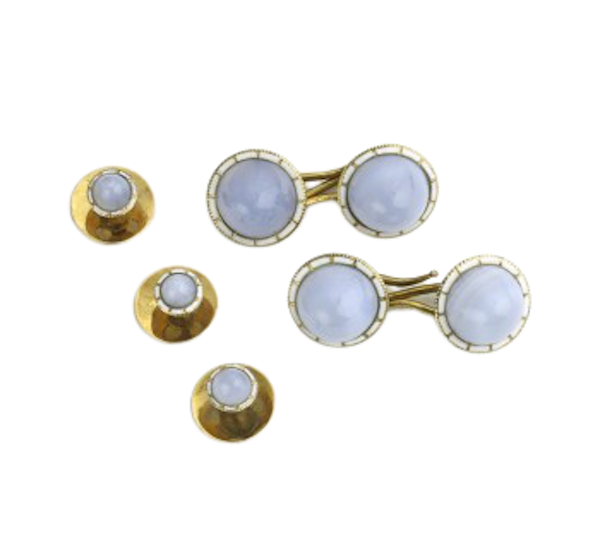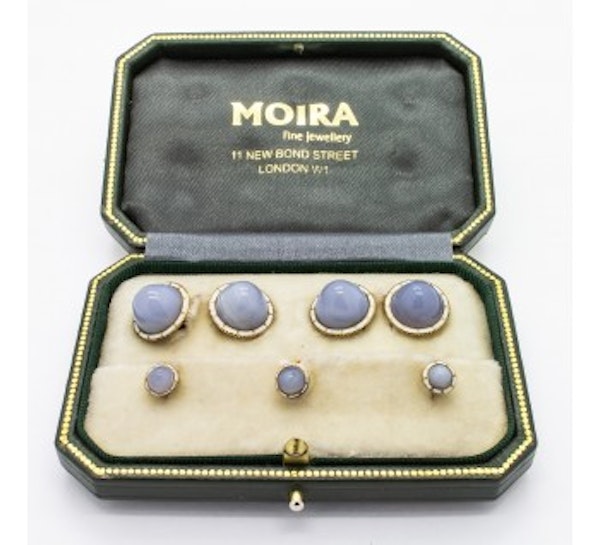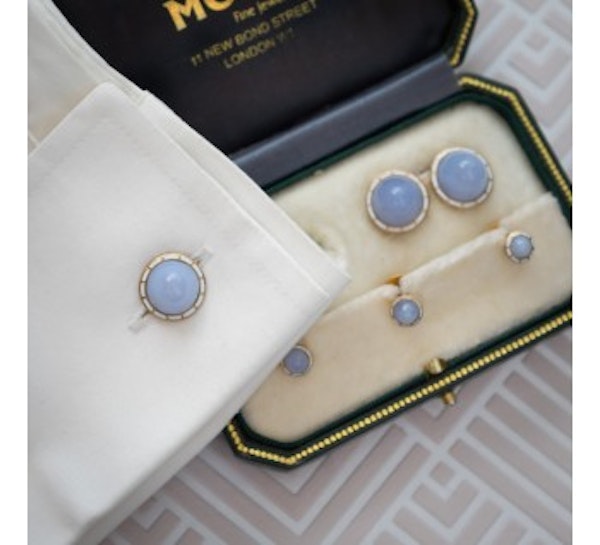Antique Blue Lace Agate White Enamel and Gold Dress Set, Circa 1910
Antique Blue Lace Agate White Enamel and Gold Dress Set, Circa 1910
£6,500.00
Description
An English, antique, gentleman's dress set, comprising a pair of cufflinks and three studs, set with high domed, cabochon-cut, blue lace agate and enamel surrounds, of white enamelled batons, mounted in 15ct gold, with S shaped links on the cufflinks and screw in plate backs for the studs, each stamped 15ct on the back, circa 1910.
Hallmarking of British Jewellery started around 1300. Until 1854, the legal standards for gold were 18ct and 22ct. In 1854 the standards 15ct, 12ct, and 9ct were added. In 1932 the 12ct and 15ct standards for gold were abolished in favour of the 14ct mark. For Scotland and Ireland, the marks and standards are marginally different.
Although all jewellery (with some exemptions) is thought to require a full array of stamps, jewellery was usually, prior to 1973, exempt from hallmarking with the exception of wedding and mourning rings. Many items, of British origin, bear only a maker’s mark and a purity mark. The full array should also include a date letter and an assay office mark. The date letter was made non-compulsory as of 1999. In 1974 a pictorial mark in the form of an orb was introduced as a purity mark for platinum.
Despite it being standardised in the mid-19th century, 15ct gold was used in the Georgian era (1714-1837). However, it is rare to find Georgian 15ct gold.
15ct gold was versatile, strong, durable, flexible and had a beautiful tone of colour so today it seems a surprise that it is no longer in use. It fell out of favour with the introduction of Art Deco styles, utilising white gold and platinum. Antique gold jewellery began to look old fashioned. America’s development as a major global power, after the First World War, to the detriment of the British Commonwealth, meant that the “American way” of doing things began to take precedence. That included gold standards and 14ct gold, known in America 14K, was introduced.
14ct gold lacks the rich warm appearance of 15ct gold and never really caught on in the UK. 18ct gold and 9ct gold are the most popular standards used in jewellery today.
With the standard of 15ct gold discontinued in 1932, antique pieces crafted in 15ct gold are becoming desirable, due to their rarity and there are collectors of this particular fineness.
With thanks to Lillicoco and Lang Antique Jewelry University
| item details | |
|---|---|
| Origin | British |
| Period | Early 1900s |
| Style | Edwardian |
| Condition | Good |
| Materials | Gold |
| Main Gemstone | Agate |
| Main Gemstone Cut | Cabochon Cut |
| Carat for Gold | 15 K |
| Dimensions | 14.2 grams |
Product REF: 16613CL2








